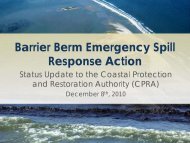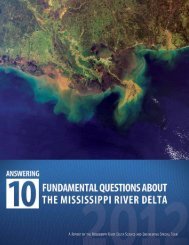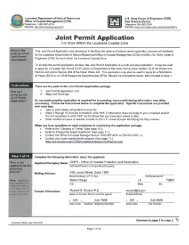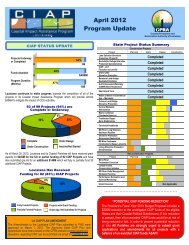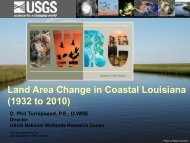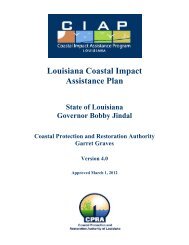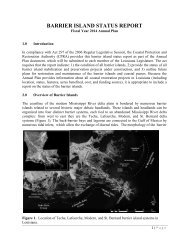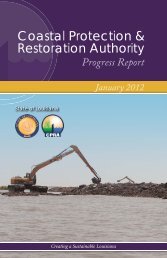Largemouth Bass Habitat Suitability Index Technical Report
Largemouth Bass Habitat Suitability Index Technical Report
Largemouth Bass Habitat Suitability Index Technical Report
Create successful ePaper yourself
Turn your PDF publications into a flip-book with our unique Google optimized e-Paper software.
APPENDIX D‐9 LARGEMOUTH BASS HABITAT SUITABILITY INDEX TECHNICAL REPORT1. Backgrounda. Purpose of ModelWith many potential actions regarding protection and restoration projects, information on theimplications of actions or inaction to the ecosystem and economy of coastal Louisiana isnecessary. Coastal land loss threatens the ecological integrity and economic viability ofLouisiana; however, understanding the implications to the ecosystem and economy as a wholeis complex. One simpler method to understand the implications of action or inaction is todevelop a predictive model that will outline responses of desired end states to various action orinaction scenarios. Among the desired end states is a healthy and robust community of animalsthat are either of direct economic importance or represent a functional ecosystem. Within thiscommunity of organisms, largemouth bass represent an economically important organism(Southwick Associates 2008), as well as, indicate a healthy freshwater ecosystem (Meador andCarlisle 2007) as an apex predator. Therefore, the expansion or contraction of largemouth basshabitats in relation to various restoration or protection scenarios offers insights into desired endstates of ecosystem integrity and economic viability by outlining the benefits of these projectsscenarios through expanded habitat and, therefore, economic activity and ecosystem integrity.This model will assist CPRA and other water management agencies (e.g., U.S. Army Corps ofEngineers) in evaluating the effect of various protection and restoration measures on largemouth bass habitat suitability. Specifically, increases, transitions, and decreases in freshwaterwill be clearly indicated by this model. Further, this model will indicate the habitat losses frominaction.b. Model Description and DepictionThe largemouth bass (Micropterus salmoides) and Florida bass (Micropterus floridanus, formerlyM. salmoides floridanus) are among the most widely sought after sportfishes in North Americaand support many popular fisheries in Louisiana. The quality of largemouth bass fisheries, interms of both fish production and angler harvest, is affected directly and indirectly by factorsunder the control of fishery managers, such as stocking practices and management regulations,as well as less controllable factors such as system productivity, invasive species, and waterquality fluctuations. For management purposes, the two species are more often described inolder literature as sub‐species and are managed together because these species are nearlyimpossible to differentiate in field settings. Specific‐level identification requires examination ofliver proteins or microsatellites. Further, the species are known to hybridize, with manyLouisiana waterbodies supporting M. salmoides, M. floridanus, and M. salmoidesXfloridanus(Constant 1990; Fries 2010). Hereafter, both species and their hybrid will be referred to aslargemouth bass, and this HSI has been generalized to address both basses and their hybrid.Coastal Louisiana freshwaters support economically and ecologically important populations oflargemouth bass. Although often overshadowed in the minds of coastal anglers by spottedseatrout and redfish, many anglers fish Louisiana coastal freshwaters targeting largemouth bass.The expenditures of these anglers are important income in coastal communities. Further, thelargemouth bass is an important aquatic predator, often a keystone predator if alligator gar oralligators are low in number. In turn, shorebirds and other avian predators are the principalnon‐human predator of bass in these systems.Published studies of largemouth bass in Louisiana coastal freshwaters are few. In Louisiana,coastal largemouth bass salinity studies have been published by Meador and Kelso (1989, 1990).Louisiana’s Comprehensive Master Plan for a Sustainable CoastPage 1



